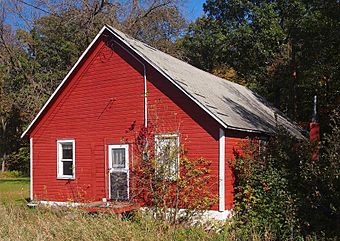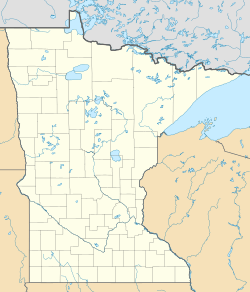Germania Hall facts for kids
Germania Hall is an old building in Germania Township, Minnesota. It was built in 1917. This hall was first used by a local music group called a community band. Later, it became a place for all sorts of events in the area. It's important because it's one of the few old community band halls left. It also served as a main gathering spot for the community for a long time.
Contents
What Germania Hall Looks Like
Germania Hall is a simple, one-story building. It's made of wood and has a pointy roof (called a gable roof). The building is about 28 feet wide and 50 feet long. It sits on a concrete base. The outside walls are made of overlapping wooden boards.
You enter through a single door in the middle of the front. Inside, there's one big room. At the back of the room, there's a stage. It's about 3 feet higher than the wooden floor.
The Germania Cornet Band Story
Around 1915, about 20 people from the area started a brass band. Having a brass band was a very popular hobby in the United States back then. This was from the mid-1800s until about 1920. The instruments were easy to learn. Also, many people wanted to hear them play. Almost every public event needed a brass band. This included fairs, grand openings, and even funerals.
Most of the band members lived on farms. Their farms were within three miles of each other. Many were young men. They were American-born sons of Swedish and Norwegian immigrants. These families had come to the U.S. in the 1880s. The oldest band member was Gustaf Peterson, who was 43. He had come from Sweden in 1892. Several band members were brothers. At least two were only 13 years old.
Learning to Play Music
Carl Peterson, one of the founders, remembered that "none of us had ever played an instrument." He also said, "we didn't even know how to read notes." But they thought it would be fun to have a band. The group hired "Professor" George Mundy. He was from nearby Eagle Bend, Minnesota. He became their band director. They paid him $5 for each practice session.
Mundy helped them order their instruments. Brass bands were so common that you could buy a whole set of instruments by mail. These sets included all the instruments and sheet music. Peterson said it was a "great day when our instruments arrived." Everyone tried to play the horns and drums. An old photo shows the band with many different instruments. They had five types of horns, three types of trumpets, three clarinets, one trombone, a snare drum, and a bass drum.
Band Uniforms and Performances
Band uniforms were almost as important as the instruments. The Germania Band's uniforms were black. They had gold braid and the letters "G.B." sewn on the collar.
The band played at concerts and barn dances in the area. They played popular local music. This included polkas, waltzes, two-steps, and some Nordic folk music. The band members did not keep any money for themselves. They put all their earnings together to pay their instructor, Mundy. In the summer of 1916, they played twice in a barn. It belonged to the family of band member Sigvard Bjerken. That December, they gave a concert in Clarissa, Minnesota.
Building Their Own Hall
At first, the band practiced in an empty building. But by March 1917, they had earned enough money to build their own band hall. Bjerken's parents gave them a free 20-year lease. It was for one acre of land at the edge of their farm. The band paid John Johnson, who lived in Clarissa, $150. He designed and built the hall. The band members also helped him with the work.
The band hall was officially opened on September 23, 1917. The ceremony included speeches and a picnic dinner. The Germania Cornet Band played, and so did other bands. There was also a "loyalty demonstration." This was to help stop unfair treatment against immigrant communities. This was happening as the United States entered World War I.
The next month, their band director George Mundy moved away. He went to Pelican Rapids, Minnesota, to start a new music group. But the Germania Cornet Band kept going without him. They held practices, concerts, and dances at their new hall. They also played at many community events. They even let others use the hall. In September 1918, a dance was held there to help the Red Cross. A local play was also performed. The township board also started using the hall for meetings and elections.
Community Use Over Time
The Germania Cornet Band stopped playing in the early 1920s. Across the country, community brass bands became less popular. This was because new ways to hear music came along. People could now listen to phonographs, watch movies, and hear the radio. Also, cars, telephones, and better roads made rural communities less isolated.
But these same changes made it easier for rural community clubs to form. The new Germania Community Club became very important for local social life. Throughout the 1930s, the club held many events at the hall. These included educational talks, talent shows, and spelling bees. They also organized a popular yearly picnic. This picnic usually had music, dancing, speeches, food, and sports. Sports included races, horseshoes, wrestling, boxing, tug-of-war, and baseball.
In 1950, the hall was given to the Germania Community Club. They bought the 1-acre lot for $50. A newspaper article from 1968 said the hall was still used often. Groups like 4-H used it for sports practices and events. School programs, talent shows, township meetings, and elections also took place there.
When the hall was nominated for the National Register of Historic Places in the mid-1990s, the Germania Community Club still held monthly meetings and dances there. The local government now meets in a different building. But the old hall is "still used for occasional dances, parties, and even as a large family’s hunting headquarters."
See also




